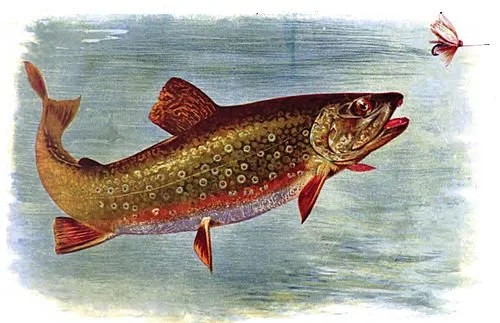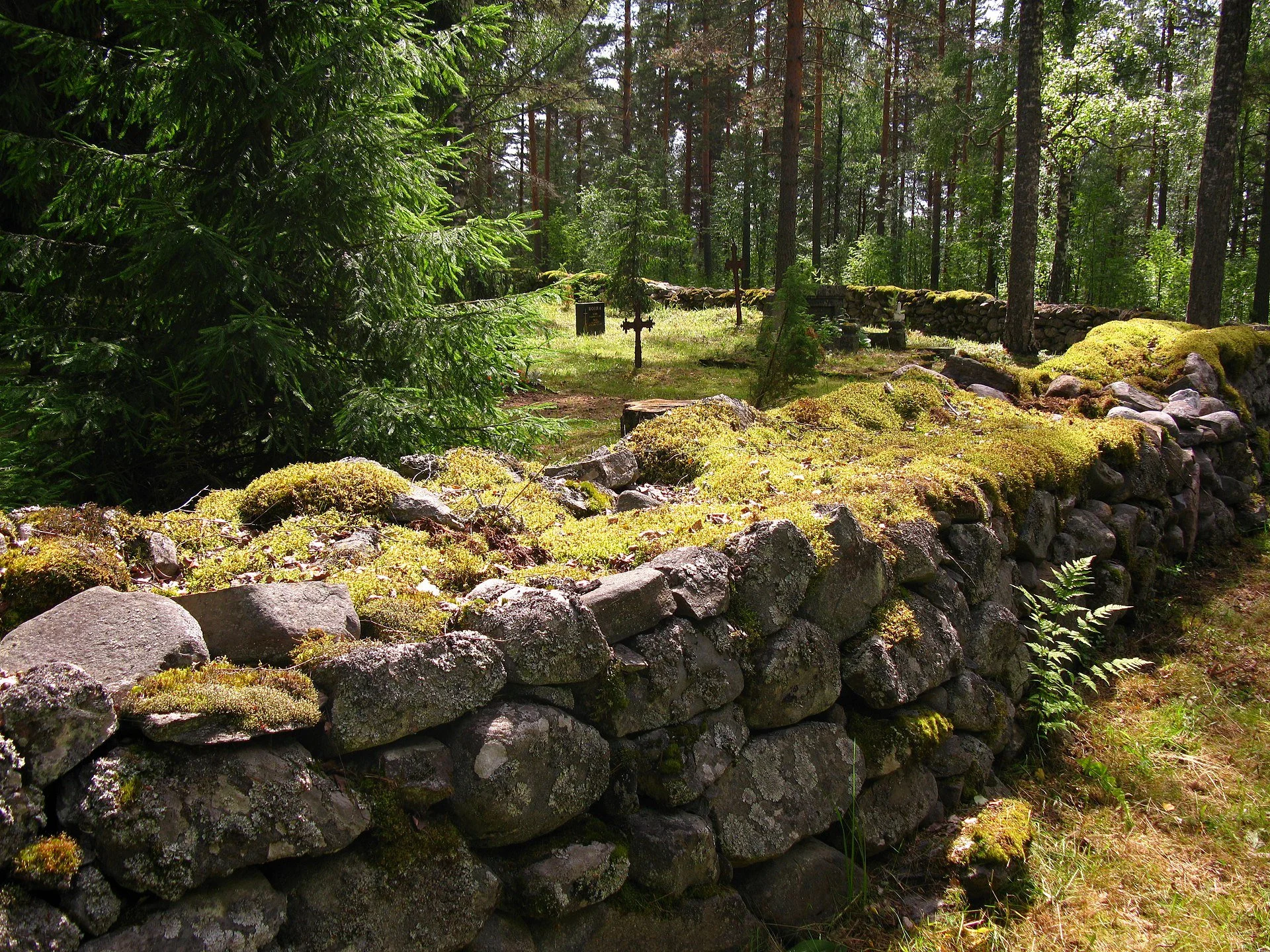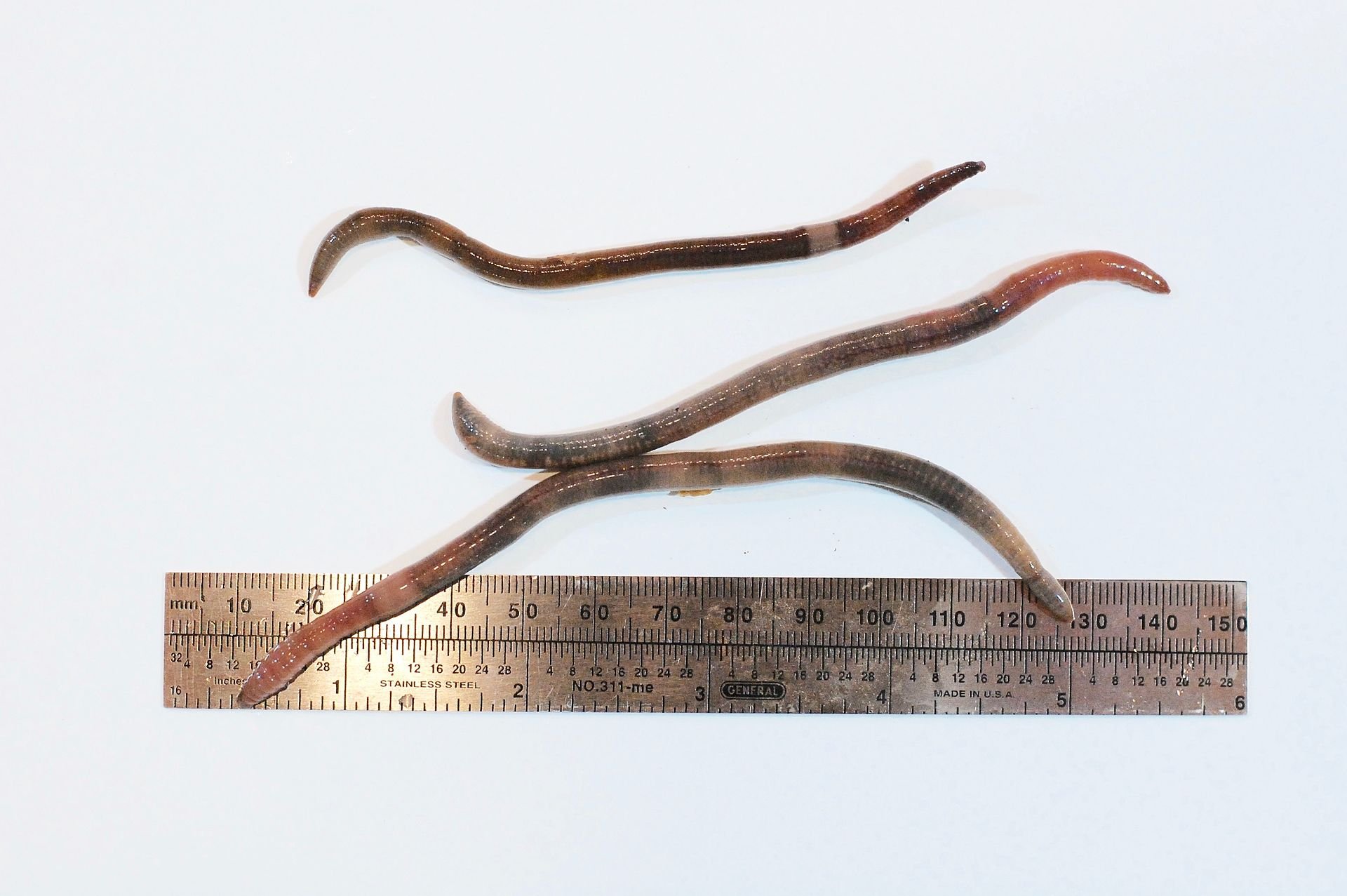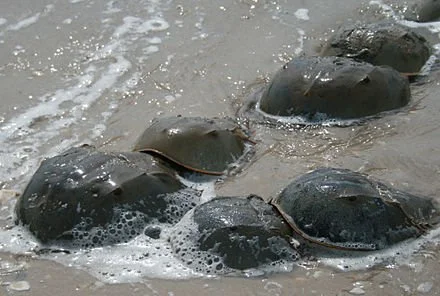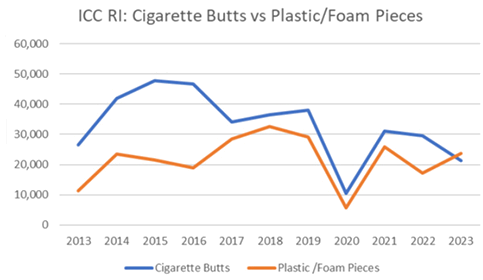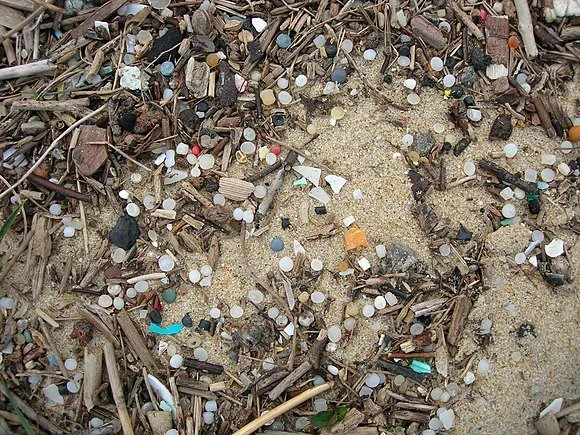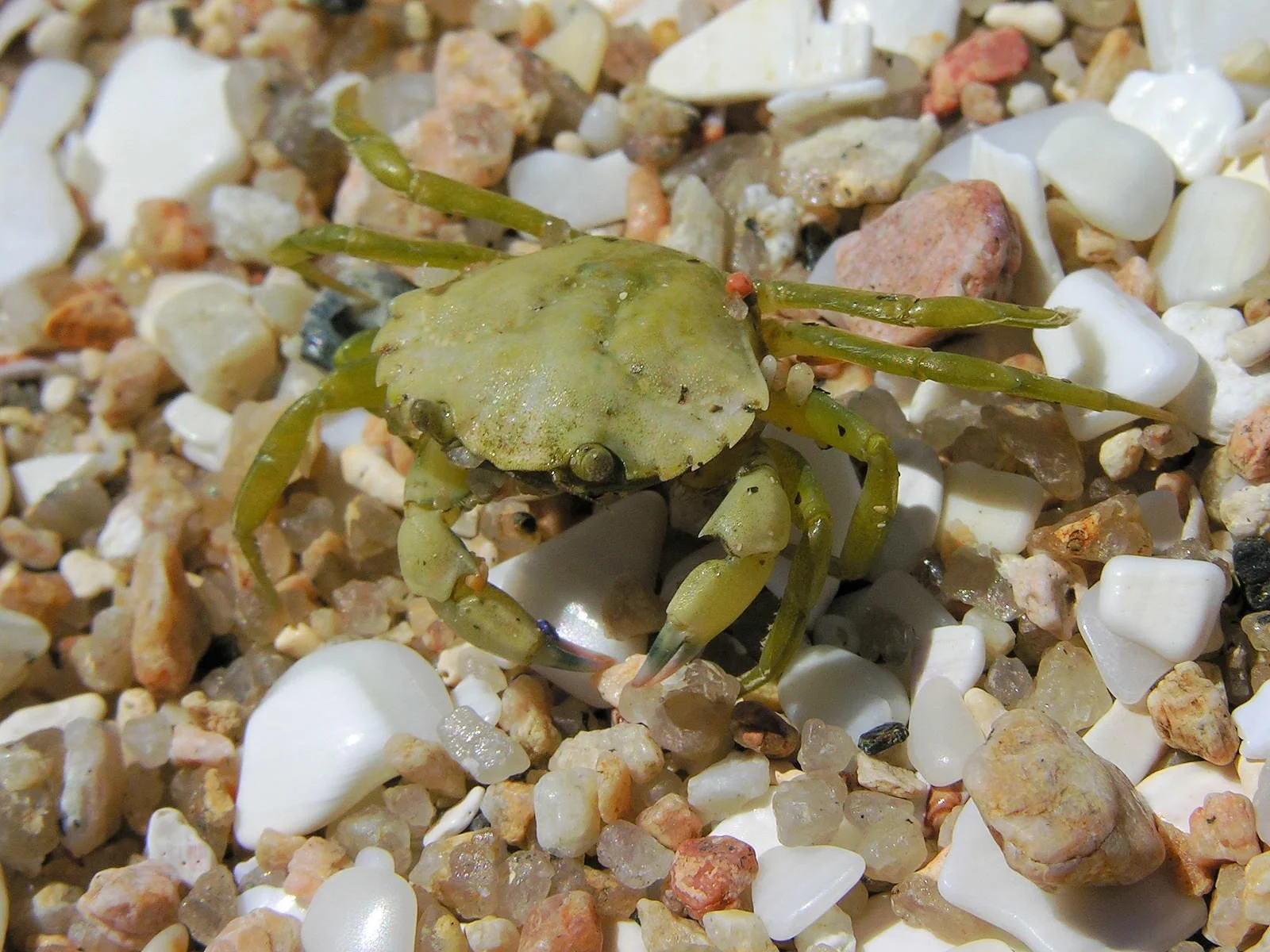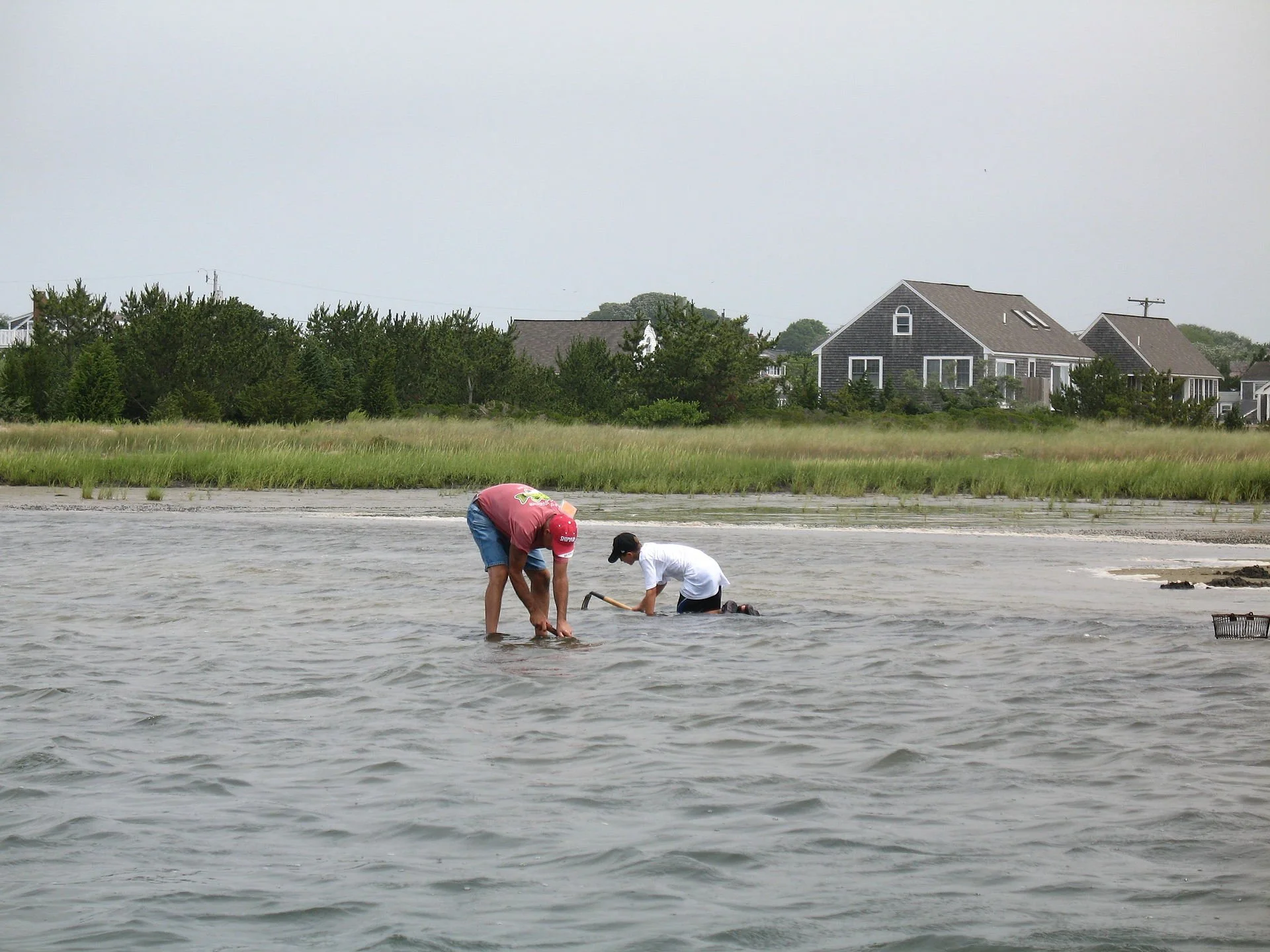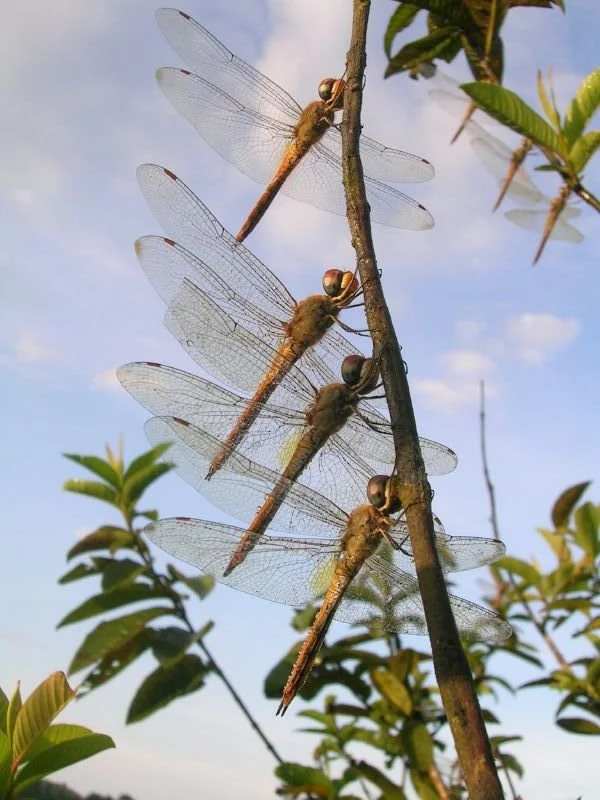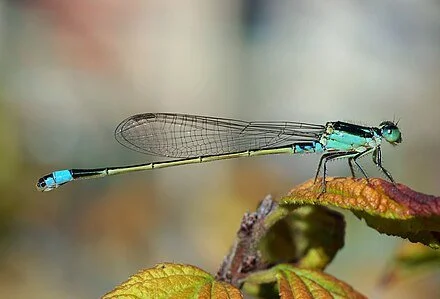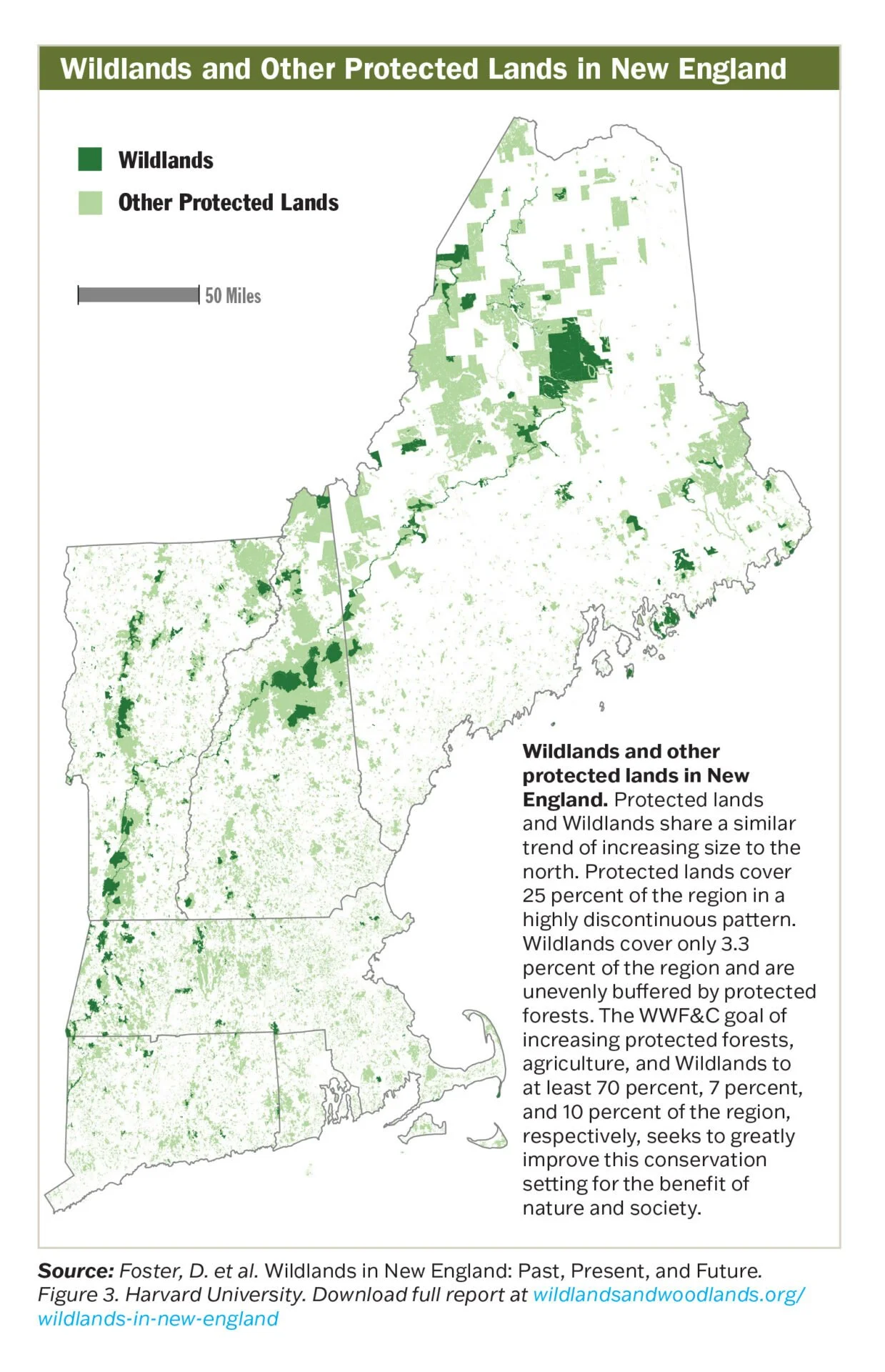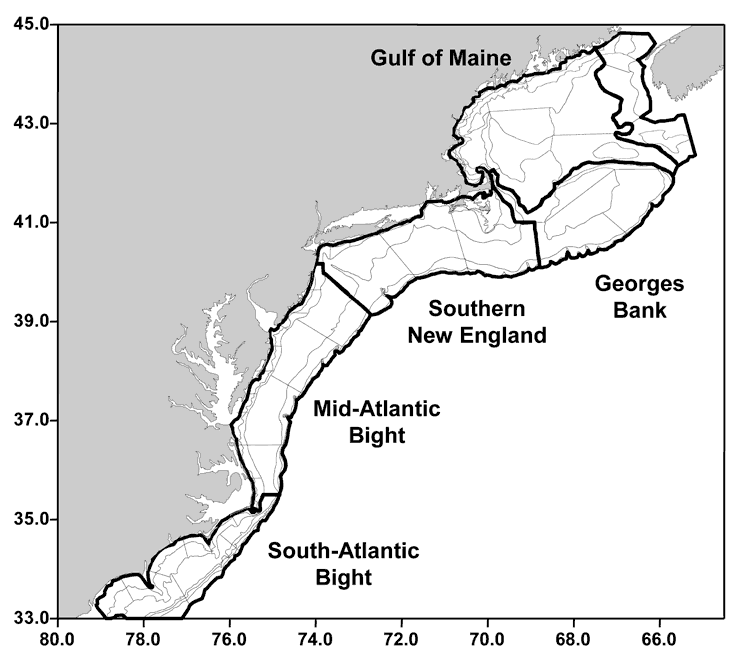
‘No native plants, no native bugs’
Larvae of Swallowtail butterfly caterpillars, which feed on the leaves of the Spicebush shrub, which is native to New England.
Text excerpted from ecoRI News, but not image above
The names of two local native nurseries, both named after insects, that opened in the past few years send a pertinent message, even if one of the bugs is a hunter rather than a pollinator. The connection is obvious, or at least it should be. There are of course exemptions, but the vast majority of insects are beneficial to human survival.
If we were to take a step back from the popular bumper sticker “No Farms No Food,” “No Bugs No Food” would be the result. Another step back would give us “No Native Plants No Native Bugs.”
At that stage, we would be very hungry, or, as Emily Dutra, owner of one of those new nurseries, noted, dead. She shared that a native oak tree can “host, like, over 750 types of caterpillars. And you know what baby birds love more than anything? Nice, soft, juicy caterpillars.”
The key ecological role of bats in New England
A Big Brown Bat Big (species found in New England) in flight.
— Photo by Rhododendrites
From an article by Frank Carini in ecoRI News’s series Wild New England, except for picture above.
“Across North America dichlorodiphenyltrichloroethane (DDT) and other pesticides had a significant impact on bats from the 1940s through the ’60s. Since the ban of DDT, in 1972, bat populations had been slowly recovering, until a fungal disease appeared three-plus decades later.
“Bat populations crashed again, when white-nose syndrome was discovered in a New York cave in 2006. The fungus that causes the disease spread rapidly across much of the United States, and the number of bat species that hibernate in caves and mines plummeted….
{But bats seem to be overcoming their latest challenges.}
‘‘These mammals play a vital ecosystem role. The nine bat species found in southern New England are insectivores, meaning they eat insects such as mosquitoes and some moths humans would label pests. It’s been estimated that an individual bat can eat 600 insects an hour. Nearly 70% of bat species feed primarily on insects. Some eat fruit, rodents, frogs, and fish….’’
Frank Carini: N.E. freshwater fishing in hot water
Eastern brook trout chasing an artificial fly, as illustrated in American Fishes (1903)
Excerpted (except for picture above) from an article in an ecoRI News series by Frank Carini. The series reports on how the region’s collection of native species is under threat on several fronts, most notably from humanity’s shortsightedness. Humans aren’t giving the natural world the space it needs and deserves. We’re crowding out nonhuman life, which, in turn, makes nature less productive and us less healthy. Wild New England examines the animals and insects most at risk.
Warming waters, which correlates to lower oxygen levels, changes in stream flow, and exacerbates aquatic stressors such as algal blooms and polluted stormwater runoff, are a significant threat to freshwater ecosystems and the fish they host. As waters warm, cold-water species will be replaced by fish suited for warm waters, causing nonnative species to take over ecosystems.
The climate crisis impacts where fish can live and how they reproduce and grow. These changes impact warm-water and cold-water fish differently. Eastern brook trout, for instance, are dependent on cold-water habitats. But climate change — fueled by the burning of fossil fuels — is causing streams to warm, shrinking the species’ range.
Eastern brook trout are also sensitive to water pollution caused by fertilizer runoff and acid rainfall caused by air pollution. These impacts have resulted in water pH levels being too low to sustain them, according to the U.S Fish & Wildlife Service. These impacts are also making their habitat unsuitable and affecting their spawning capabilities.
Here’s the full article.
Frank Carini:Trying to save Timber Rattlesnakes, which play useful ecological roles in New England
Timber Rattlesnake
— Photo by Glenn Bartolotti
Text edited and excerpted from an ecoRI News article by Frank Carini
“Providence’s Roger Williams Park Zoo, partnered with New England biologists and conservationists 14 years ago to try to save the region’s remaining Timber Rattlesnake populations.
“The project aligned perfectly with Lou Perrotti’s passion and experience. The zoo’s director of conservation programs believes that it is the responsibility of state wildlife agencies and other stakeholders, such as zoos and aquariums, to protect every species considered to be threatened or endangered, no matter how big or small. They all, even venomous snakes, play a role in ecosystem health.
“For example, research has shown that Timber Rattlesnakes help keep the occurrence of Lyme disease down by preying on deer mice, a popular host of the Lyme-carrying deer tick.
“The Northeast’s population of Timber Rattlesnakes, however, remains in serious decline, because of habitat loss, road mortality, and indiscriminate killing. Perrotti has noted this species historically has had a bounty on its head, which was a significant cause of its extirpation from Rhode Island in the late 1960s.’’
Colorful and Threatened necrophiliac
Female American Burying Beetle.
Excerpted and edited from an ecoRI News article by Frank Carini.
Series note: The region’s collection of native species is under threat on several fronts, most notably from humanity’s shortsightedness. Humans aren’t giving the natural world the space it needs and deserves. We’re crowding out non-human life, which, in turn, makes nature less productive and us less healthy. Wild New England examines the animals and insects most at risk.
The American Burying Beetle, thanks to the efforts a decade ago by third-graders at St. Michael’s Country Day School in Newport, is Rhode Island’s state insect. The students’ effort helped raise awareness about this orange-spotted insect with an interesting occupation.
After sniffing out a freshly dead animal from up to 2 miles away, the rare beetle, whose continued existence is listed as threatened, joins a mate in burying the carcass, stripping it of fur or feathers, rolling it into a ball, and covering it in oral and anal fluids to preserve it as a shelter and food source for the pair’s litter of larvae.
Nicrophorus americanus, the largest carrion beetle in North America, is native to at least 35 states and the southern borders of three eastern Canadian provinces.
New England stone walls house many creatures
Excerpted/edited from an ecoRI News article by Colleen Cronin
LITTLE COMPTON, R.I.
A look at a stone wall on Roger and Gail Greene’s property — they guessed the structure dates back to the early 1800s or even late 1700s — suggests that every rock and cranny is a world unto its own.
A black cherry tree stretched its way up and out from underneath — a gift likely planted by a bird who had perched on its stones decades ago, Roger said. Minty green lichen made splotches on gray rocks. A pickerel frog with skin like a snake hopped its way through leaf litter and low grasses to a hiding space before an ecoRI News reporter could get a good photo.
Stone walls originally marked the boundaries of farms, but now they have become homes to many different types of creatures.
Nature-based ways to mitigate disasters
A coastal salt marsh in East Lyme, Conn., along Long Island Sound. Restoring coastal wetlands helps reduce the damage from storms and rising seas associated with global warming. (Photo by Alex756 )
Excerpted from an ecoRI News article by Frank Carini
“A new global assessment of scientific literature led by researchers at the University of Massachusetts at Amherst found that nature-based solutions (NBS) are an economically effective method to mitigate risks from a range of disasters, including floods, hurricanes, and heat waves — all which are expected to intensify as the planet continues to warm.
“NBS solutions are interventions where an ecosystem is either preserved, sustainably managed, or restored to provide benefits to society and to nature. For instance, they can mitigate risk from a natural disaster, or facilitate climate mitigation and adaptation. They have emerged in combination with or as an alternative to engineering-based solutions, such as restoring wetlands to address coastal flooding rather than building a seawall.’’
Those jumping worms
Jumping worms
-- Photo by Njh5880
Excerpted from an ecoRI News article
CRANSTON, R.I.
“An infestation of jumping worms, also known as snake worms, has forced the Rhode Island Wild Plant Society to cancel its August native plant sale.
Pat Foley, president of RIWPS, wrote in an email, ‘We have decided to cancel our upcoming native plant sale. Based on conversations I had this week with the volunteers planning the sale, we learned that invasive ‘jumping worms’ were discovered in some of the plant trays we were readying for the sale.’
“Even though the invasive worms look similar to the region’s more common earthworm, their behavior easily identifies them. They slither through the grass like snakes and jump away if they are disturbed. In their native Korea and Japan, they are called Asian jumping worms.’’
Invasive species are crowding out New England’s native species
An Asian shore crab
Multiflora rose
Text excerpted from an ecoRI News article by Frank Carini
“Invasive Asian shore crabs are outcompeting young lobsters. Invasive snake worms and hammerhead worms are burying themselves deeper into southern New England, where the former consumes the top layer of soil and dead leaves where the seeds of plants germinate, and the latter is toxic and transmits harmful parasites to humans and animals.
“Invasive multiflora rose and oriental bittersweet have long been embedded in the region, crowding out native vegetation and strangling trees. Some Rhode Island nurseries and garden centers still sell foreign species that don’t mix well with local flora and fauna.
“The spread of invasive species has long been recognized as a global threat to the environment, the economy, and people. Last summer, the Intergovernmental Science-Policy Platform on Biodiversity and Ecosystem Services (IPBES) for the United Nations issued a global assessment providing clear evidence of this growing threat.’’
Another invader from the South
Cliff Vanover knew something was wrong one night while traveling in upstate New York in 1995. His palms got itchy, then he got hives, then ‘my body was one solid hive,’ he said. He had gone into anaphylaxis, a severe allergic reaction.
“His wife had antihistamines for her own allergies, so he took some and the symptoms subsided. But then it happened again. ‘I had no allergies at the time,’ Vanover said, so he went to an allergist, who did a series of scratch tests. The Charlestown, R.I., resident learned he was allergic to beef, lamb, and pork.
“Although there was no name for it three decades ago, when Vanover contracted it, he had what is now known as alpha-gal syndrome. It’s caused by the bite of a lone star tick, and it’s going to become a lot more prevalent here in New England {as they move north}.’’
To read the full article, by Bonnie Phillips, please hit this link.
Trying to save horseshoe crabs
Horseshoe crabs mating.
Edited from a ecoRI News article by Frank Carini
“Ancient creatures with 12 legs, 10 eyes, and blue blood were once so prevalent on southern New England beaches that people, including children, were paid to kill them.
“Their helmet-like bodies can still be seen along the region’s coastline and around its salt marshes, but in a fraction of the numbers witnessed seven decades ago. There are several reasons why.
“In the 1950s coastal New England paid fishermen and others bounties to kill the up to 2-feet-long arachnids — horseshoe crabs are more closely related to spiders, scorpions and ticks than to crabs — because they interfered with human enjoyment of the shore and were viewed as shellfish predators….
“People, not just fishermen, were reportedly encouraged to toss horseshoe crabs above the high-tide line, so they would dry out and die. They were labeled ‘pests’ and ground up for fertilizer. Beachfront property owners were apparently concerned the creature’s presence and their decaying death would impact real estate values.
{Horseshoe crabs are harvested for their blood’s medical applications.}
“Those ignorant days may be over, but horseshoe crabs are facing other threats to their existence.’’
“The Center for Biological Diversity, an Arizona-based nonprofit, and 22 partner organizations recently petitioned NOAA Fisheries to list the Atlantic horseshoe crab as an endangered species under the Endangered Species Act….’’
To read the whole article, please hit this link.
Plastic pieces edge out cigarette butts as beach waste in Rhode Island
Pieces of plastic on beach.
Text from ecoRI News
“For the first time in the history of Rhode Island’s participation in the International Coastal Cleanup program, cigarette butts were not the item most collected by volunteer participants. Instead, small plastic and foam pieces — those pulverized bits that accumulate in wrack lines — took the lead, according to Save The Bay’s recently released 2023 International Coastal Cleanup Report.
“‘When this project started over 35 years ago, the focus was on recording the most common types of identifiable trash so that we could get a picture of what was littering our shores and where it was coming from,’ Save The Bay volunteer and internship manager July Lewis said. ‘In terms of the number of items picked up, cigarette butts were always at the top of the list.”’
“Last year, however, 2,830 local volunteers collected 23,468 plastic and foam pieces — and 21,165 cigarette butts.’’
To read the whole article, please hit this link.
— Save The Bay graphic
Mary Lhowe: The ‘lunchbox’ from offshore wind turbines
Text from ecoRI News article by Mary Lhowe
“Opponents of offshore wind offer different reasons for their position: fear of impacts on the marine ecology; fear of loss of income for fishers; fear of loss of tourism dollars and private property values due to the sight of the turbines on the horizon.
“The cloudy threat of wind projects off the New England coast comes with a golden — not silver — lining. That gold would arrive in the form of millions of dollars contractually promised to communities by developers in the form of mitigations, sometimes through a mechanism called host community or good neighbor agreements.
Even the towns and historic property owners who dread wind farms but yearn for funds to do worthy projects could be excused for reacting to mitigation deals in similar fashion to the character Gaz in the movie The Full Monty. Watching men audition for a new amateur dance troupe, Gaz observes the impressive talents of one particular auditioner, and mutters, “Gentlemen, the lunchbox has landed.”
To read the whole article, please hit this link.
Frank Carini: We need bats
An Eastern Small-Footed Bat, of a species found in New England.
Hollywood and literature routinely portray bats as blood-sucking monsters. It’s entertaining, but in reality, humans are a much bigger threat to these winged mammals than they are to us. In fact, their presence is beneficial in numerous ways.
Bats play an important role in the control of mosquitoes and agricultural pests. They save the United States about $1 billion annually in pest control. Bats in the Southwest and other warm areas around the world help plants grow by pollinating flowers. When nectar-drinking bats stick their long noses into flowers, they become covered in pollen that they then bring to other flowers. Through pollination, bats help grow avocados, bananas, and mangoes. In all, some 300 species of fruit depend on bats for pollination.
Also, of the 1,400 or so bat species worldwide, only three — the Common Vampire Bat, the Hairy-Legged Vampire Bat and the White-Winged Vampire Bat — feed solely on blood, mostly that of birds. You would have to travel much further south than southern New England to find one….
The eight species of bats that can be found in Rhode Island are divided into two classes: tree bats (Eastern Red Bat, Hoary Bat, and Silver-Haired Bat) and hibernators (Little Brown Bat, Big Brown Bat, Tricolored Bat, Northern Long-Eared Bat, and Eastern Small-Footed Bat). They are all insectivores.
To read the whole article, please hit this link.
The great invasion
Text from article by Frank Carini in ecoRI news
A worldwide scientific intergovernmental group on biodiversity, which included a professor from the University of Rhode Island, provides evidence of the global spread and destruction caused by invasive alien species and recommends policy options to deal with the challenges of biological invasions.
The comprehensive report, released Sept. 4 by the Intergovernmental Science-Policy Platform on Biodiversity and Ecosystem Services for the United Nations, found the threat posed by invasive species introduced into new ecosystems is “enormous.”
In 2019, invasive species caused an estimated $423 billion in damages to nature, food sources, and human health. These alien invaders have also contributed to 60% of recorded animal and plant extinctions, and were the sole factor in 16% of extinctions, according to the report.
“This is the first global report on invasive alien species anywhere,” said Laura Meyerson, a URI professor in natural resources science and a contributing lead author on the report. “It’s truly an effort of scientists from around the world. The data touch on every world region, every biome and all major taxa — plants, vertebrates, invertebrates, micro-organisms, fungi.”
Invasive species pose to a threat biodiversity, ecosystem services, and human well-being. The report is designed to raise public awareness to “underpin action to mitigate the impacts of invasive alien species.”
To read the whole article, please hit this link.
Frank Carini: In search of dragons and damsels
Dragonflies during migration
— Photo by Shyamal
From ecoRI.org
SOUTH KINGSTOWN, R.I. — Virginia Brown and Nina Briggs have been hunting dragons for three decades. They have spotted thousands. Capturing one is a bit more difficult. They can be up in a tree out of reach or hidden in leaf litter below. Catching one by hand is toilsome.
These dragons, glistening in shades of black, blue, brown, green, red, and yellow, are some of the most colorful creatures on the planet, with intricate patterns of stripes and spots. To Brown and Briggs, they are also some of the most elegant insects on Earth.
These aerial assassins have been around for about 300 million years. They survived the asteroid that killed the dinosaurs. They have, so far, survived humankind’s destructive nature.
They can be found buzzing around in the swampy wilds of Rhode Island. In the summer, these winged acrobats perform stunts above and around ponds, lakes, streams, bogs, marshes, and rivers.
On a recent Saturday morning at the Great Swamp Management Area off Great Neck Road here,where the two conservationists guide public “hunts,” the longtime Rhode Island residents took this ecoRI News reporter on a 2-hour adventure in search of dragonflies and damselflies. See Brown’s book about these creatures.
My guides noted their favorite insects demonstrate charismatic behavior, possess an ancient evolutionary history, and play an important role in the ecology of aquatic habitats.
Virginia Brown, whose hat aptly captures her fondness for dragonflies and damselflies, has a keen eye for finding her favorite insects. To read the whole article, please hit this link.
Frank Carini is senior reporter and co-founder of ecoRI News
Damselfly
Study says New England needs to protect much more wildlands
Excerpted from ecoRI News by Rob Smith
PETERSHAM, Mass. (home of Harvard University’s research forest)
“New England isn’t conserving enough wildlands to mitigate climate change or meet conservation goals.
“That’s according to a new study released late last month by Wildlands, Woodlands, Farmlands and Communities (WWF&C), a coalition group of conservation organizations, educational institutions, local governments and private nonprofits.
“The first-of-its-kind analysis, performed jointly by (the} Harvard Forest of Harvard University, the Northeast Wilderness Trust and Highstead Foundation, examined how much wildlands — tracts of land where the management policy is to leave nature ‘alone’ and allow natural processes to prevail without human interference — are preserved across the region, and the answer is: not much.
“‘The wild condition of the land derives not from the land’s history, but from its freedom to operate untrammeled, today and in the future,’ wrote the study’s authors.
“The study lays out three criteria for land to meet its wildlands definition: the land must have a deliberate wildland purpose; it must be allowed to mature freely under prevailing environmental conditions with minimal human intervention; and it must be protected in perpetuity.
“The key factor in wildlands is time. In New England, where much of the land has been developed and used, wildlands are more likely to develop via natural rewilding, an ecological restoration practice that aims at reducing the influence of humans on ecosystems. Wildlands are more likely to look like recently clear-cut areas or former pastures than old growth forest.
“Only 1.3 million acres, around 3.3% of New England’s total land area, protects wildlands across 426 individual properties, with much of it limited to the remote and rural areas of the region, a band of land that stretches from northwestern Connecticut to Baxter State Park in Maine. Meanwhile WWF&C has set a goal of preserving 10% of the region as wildlands.’’
Diorama at the The Fisher Museum at the Harvard Forest, which offers exhibits on current research as well as 23 dioramas portraying the history, conservation and management of New England woodlands.
Studying New England birds’ perilous migrations
Male (left) and female (right) American goldfinches at a thistle feeder. The American goldfinch can be found in Rhode Island year-round, though some individuals migrate south during the non-breeding season.
From an article by Bonnie Phillips in ecoRI News:
“Scientists and biologists know much more about bird migration now, why they do it and, for the most part, how. Almost half of all birds migrate in some form or another. Many migrate at night, when the weather is calmer and there are fewer predators. Some birds travel as far as 7,000 miles nonstop, and others return to the same locations year after year.
“Migration takes a toll on birds — it’s a dangerous time, when the exhausted birds are especially vulnerable to predators, deteriorating habitat, and climate change. Researchers are realizing that it’s vital to understand migration patterns and habitat usage to prevent further loss of already declining bird populations.
“‘The more bird migration comes into focus, the more we realize that, to conserve our declining birds, we must focus our attention on these strenuous and perilous periods in their lives,’ said Charles Clarkson, director of avian research at the Audubon Society of Rhode Island.
“The society’s recently released State of Our Birds Part II report is a start toward examining the habits of birds that use Audubon’s 9,500 acres of refuges as stopovers on their migrations. Research suggests Rhode Island — the {rural/exurban} western part of the state in particular — is more important than any other New England location for migrating birds.’’
To read the full article, please hit this link.
#birds #Rhode Island
‘Ropeless’ fishing has promise to protect whales but adds costs, complications to industry
Text from article by Mary Lhowe in ecoRI News.
A handful of Rhode Island lobster fishermen are working this season with federal regulators to use and study some complex and early stage equipment that is intended, eventually, to greatly reduce entanglements and deaths of whales.
The experimental equipment for this so-called “ropeless” fishing would eliminate the vertical ropes — or “lines” — running down the water column from buoys on the surface to lines connecting a series of traps on the seafloor. The existing function of buoys and vertical lines — to find and retrieve traps — would be replaced under a new system by computerized acoustic signals from boats to the seafloor and geopositioning via cell signals or satellites.
Using federal experimental fishing permits, three Port Judith-based lobstermen are struggling to use the new gear, borrowed from the National Marine Fisheries Service (NMFS), a branch of NOAA Fisheries.
To read entire article, please hit this link.
Frank Carini: The staggering hypocrisy of the anti-offshore wind farm crowd
From Frank Carini’s column “Whale of a Tale: Local Anti-Wind Crowd Spins Yarns,’’ in ecoRI News (ecori.org)
”No energy source is benign. From installation to operation, they all come with consequences — environmental, societal, and cultural. Some more than others. Legitimate concerns (e.g., not infringing upon whale migration corridors) must be studied, discussed, mitigated, and/or avoided. Renewable energy shouldn’t be called clean, but it is a whole lot cleaner than fossil fuels….
“The concerns of southern New England’s anti-offshore wind crowd, however, never spill over to the polluting gas and oil platforms that mar many of the waters off the U.S. coast, especially in the Gulf of Mexico. Probably because there are no such rigs in Rhode Island Sound.
“They don’t mention sonar {which can disturb marine mammals} is used to detect leaks from offshore fossil fuel infrastructure. They fail to note ocean military training drills use sonar, and live munitions. They disregard the fact the primary causes of mortality and serious injury for many whales, most notably the North Atlantic right whale, are from entanglements with fishing gear and vessel strikes.
“Even though data show that North Atlantic right whale mortalities from fishing entanglements continue to occur at levels five times higher than the species can withstand, the anti-wind crowd isn’t calling for fishing gear to be pulled from local waters or the use of ropeless fishing technology made mandatory. They aren’t demanding vessels be equipped with technology that monitors the presence of whales in shipping lanes.
“They ignore the fact the development of offshore wind is the most scrutinized form of renewable energy. After reading this column, they will allege I and/or ecoRI News are in the pocket of Big Wind. We’re not. (A few wind energy companies have advertised with us, but they didn’t spend nearly enough to bankroll a golden parachute, or even a reporter’s salary for a month.)
“The anti-wind crowd doesn’t offer any real solutions to drastically reduce the amount of heat-trapping, polluting, and health-harming greenhouse gases that humans are relentlessly spewing into the atmosphere.’’
To read the full column, please hit this link.


